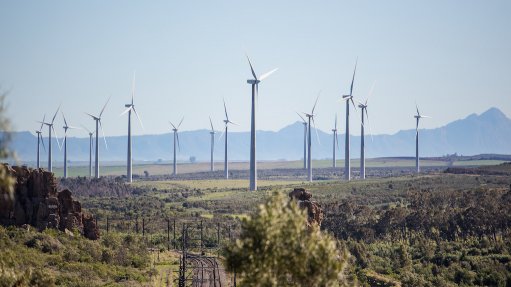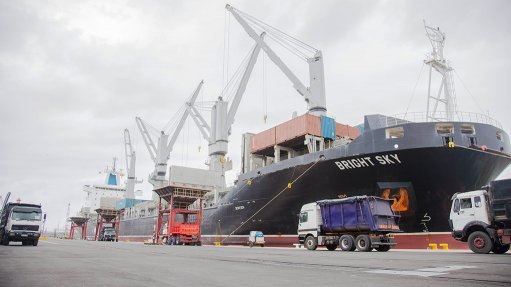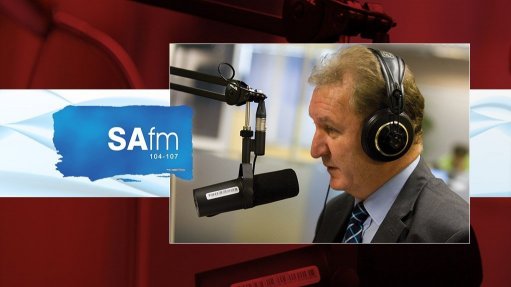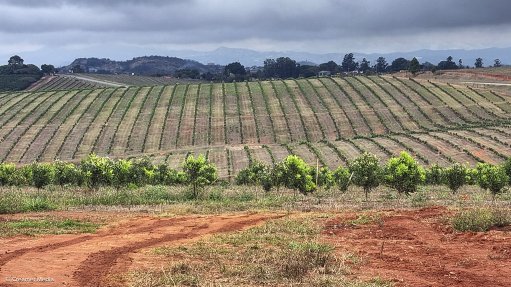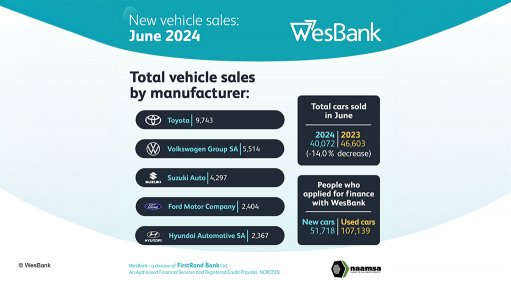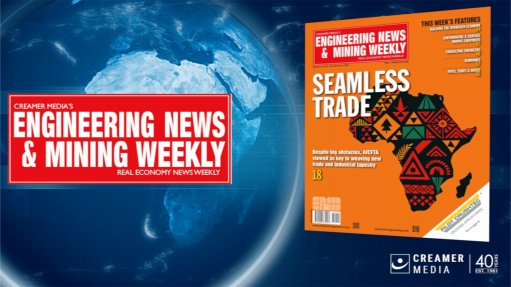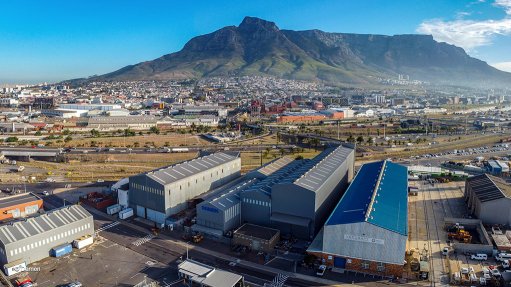Fast-greening Richards Bay Minerals now eyeing on-site renewables, storage, aggregation

Richards Bay Minerals' Bradley Reddy interviewed by Mining Weekly's Martin Creamer. Video: Darlene Cereamer.
JOHANNESBURG (miningweekly.com) – Energy-intensive Richards Bay Minerals (RBM), which consumes an average of 1.8 terawatts of power a year, was able to secure its latest 140 MW wind energy power purchase agreement (PPA) in six months.
When operating at full capacity, RBM's power consumption across its mining and smelting operations can reach up to 400 MW and this month’s quickly concluded wind PPA was, in fact, the second renewable-energy project of this Rio Tinto company.
The first, launched in 2022, was Bolobedu solar PV plant with Voltalia in Limpopo and being looked at now are on-site renewable-energy and energy-storage options, as well as how it may partner with other companies to halve emissions in 2030 and get to net zero by 2050.
“As a business and as a group, we've come a long way in understanding the markets,” RBM GM: Growth Strategy Bradley Reddy outlined to Mining Weekly in a Zoom interview. (Also watch attached Creamer Media video.)
“We do see the markets evolving and with the number of aggregators likely to come up in the next six to 18 months, there'll be further opportunities where there could be shorter offtakes as well,” Reddy added.
The aggregation procurement model involves many energy projects selling to one buyer, who in turn sells to many mines, which is being viewed in some circles as a key financial tool to accelerate the energy transition of South Africa’s mining industry.
This heavy mineral sands extraction and refining company produces materials used in a wide range of everyday products from paints to smartphones.
Its principal product is titanium dioxide in the form of an 85% pure titanium dioxide slag and it also produces the higher-purity 95% titanium dioxide product rutile as well as pig iron and zircon.
Electricity consumption, besides being one of its largest cost elements, also makes up about 80% of the company’s carbon emissions.
Being part of Rio Tinto has enabled RBM to leverage on areas of expertise across the globe.
Parties to this month’s 20-year wind energy agreement include African Clean Energy Developments (ACED), The IDEAS Fund (managed by African Infrastructure Investment Managers), investment holding company Reatile Group, and Rand Merchant Bank. In addition, Energy Infrastructure Management Service (EIMS) Africa is responsible for asset management for the project.
Once constructed, the latest Khangela Emoyeni Wind Farm arrangement involves the production of 460 GWh/y of renewable energy, which, through a wheeling agreement with State power utility Eskom, will help to power RBM’s operations.
The project, with an export capacity of 140 MW, is scheduled to reach commercial operation within 28 months.
Combined, the wind and solar projects will supply 42% of RBM’s existing energy needs and present opportunities for job creation, skills development, and knowledge transfer within local communities surrounding the project sites during both the construction and operational phases.
Mining Weekly: At the media briefing earlier this month, ACED GM James Cumming said your latest wind farm PPA was completed in what he considered to be record time. How was this concluded in only six months when you’ve taken more than double that time for other deals that you’ve worked on?
This was successful by having like-minded partners who share the same values. The level of trust and the frank open discussions allowed us to be able to conclude the PPA negotiations with a much more pragmatic approach. Having our lenders there as well enabled us to knock out a deal within a very short space of time, including getting financial close.
What are some of RBM’s most important considerations when going into a PPA, to ensure long-term value?
RBM, as part of Rio Tinto, wanted to ensure that, as an energy-intensive company, which consumes an average of 1.8 terawatts of power per annum, we effectively were able to mitigate, to a large extent, our carbon emissions. Our electricity consumption comprises about 80% of our carbon emissions, with the balance of 20% resulting from our process. At the same time, we wanted to address power, which is one of the largest cost elements that we’re currently incurring. With global competitiveness being quite key for us, the sustainability of the business to enable us to go into the green transition, was meant to be done in a way that is not only cost effective, but also maintains security of supply. For us, those were key elements to deliver long-term value for the business.
What were RBM’s criteria for the selection of the partners?
We released a competitive tender and we had a very rigorous process. We looked at the technical and commercial aspects. Key areas on which we focused were the reputation and capability of the independent power producer (IPP), the cost of the tariff they were proposing, the location of the project, the shovel readiness, the technology and generation profile.
This is RBM’s second PPA. What are some of the lessons learned so far in brokering renewables agreements?
I would say that, as a business and as a group, we've come a long way in understanding the markets. We've developed our carbon abatement strategy, working with our advisers, and continue to assess the key assumptions. We found the market to be quite fluid and, I think from a buyer perspective, the market has improved quite a bit. The benefits of government relaxing certain legislation, and encouraging private partners to participate in solving the energy crisis, were key to helping us progress. The market has evolved, and partnering with advisers was one of the key things from a success factor perspective.
How is your project team at RBM composed? We understand it falls within your growth strategy mandate, but what core competencies reside within it and what is the team’s scope?
The project was largely led by our energy management department. It's not a large department, but it's resourced with skilled and talented individuals. Our focus is not only on improving our energy consumption, but also on how we decarbonise as well. We supplemented the skills we have within RBM with some of the technical, legal and commercial resources from the Rio Tinto group that really supported us throughout the process. Being part of Rio Tinto, we were able to leverage on the areas of expertise across the globe to be able to support us on the project. For us, that was quite key, because our local team and our local advisers had a good understanding of the markets. However, the global technical skills came in, business advisory as well, so as a collective, from a Rio Tinto perspective, we were able to deliver this project. We were able to also ensure that we balanced the commercial and the technical to ensure that, even from an IPP perspective, we were able to close the deal and have a mutually beneficial PPA.
Can you talk about some of the other strategies planned or in place at RBM to reduce Scope 1 and Scope 2 greenhouse-gas emissions?
Rio Tinto subscribes to the Paris Agreement. As a business, we want to focus on reducing our carbon emissions by 50% in 2030 and be carbon neutral by 2050. From our point of view, setting up and developing our carbon strategy was key to understand the regulatory framework and then know the challenges within the current markets that we operate in. Looking at where RBM is located within the KwaZulu-Natal region, we felt that most of our renewable penetration would come through a wheeling framework. We looked at those projects that were shovel ready and able to be negotiated and closed off. There is grid constraint across the market and we wanted to be one of the first movers to be able to capture this opportunity to decarbonise the business. As we increase our renewables penetration, we will look at storage options as well. We are looking at on-site renewables options and how do we partner with other companies as we increase our renewables penetration to get to net zero. We have got a multifaceted carbon abatement strategy that will leverage on the current resources, and then as the markets evolve, make sure that we able to capture those opportunities as well.
As large consumers of energy, mining companies are showing their commitment to reducing the load on the national grid through renewables. What would be your advice to your peers in mining companies yet to pursue a PPA?
The important thing is to build your strategy alongside your goals of what the business wants to achieve and then identify what resources and opportunities reside within the current markets. We do see the markets evolving and with the number of aggregators likely to come up in the next six to 18 months, there'll be further opportunities where there could be shorter offtakes as well. So, it's important to get advisers that understand the current market and are able to give you the necessary direction that you need to develop your strategy, because some of the offtakes could be five to 20 years, and you want to ensure that these contracts are aligned with your broader business strategy and give you the agility that you actually require.
POWER AGGREGATORS
Although aggregators are collectively called traders and are licensed as such, they do not sell over the counter, as it were, but take the green electrons from multiple sources and sell them to multiple offtakers.
They are able to trade pliably off a single platform for the short term or the long term, which provides important flexibility.
A critical component for mines is to attain net zero, and to assist mines to do so optimally, the aggregator energy structure of many independent power producers selling to one aggregator or one platform is being viewed as a potential panacea.
Interestingly, while the energy transition has a strong commercial bent, wanting to do the right thing for the benefit of future generations is also very evident in many renewable-energy transactions.
Comments
Press Office
Announcements
What's On
Subscribe to improve your user experience...
Option 1 (equivalent of R125 a month):
Receive a weekly copy of Creamer Media's Engineering News & Mining Weekly magazine
(print copy for those in South Africa and e-magazine for those outside of South Africa)
Receive daily email newsletters
Access to full search results
Access archive of magazine back copies
Access to Projects in Progress
Access to ONE Research Report of your choice in PDF format
Option 2 (equivalent of R375 a month):
All benefits from Option 1
PLUS
Access to Creamer Media's Research Channel Africa for ALL Research Reports, in PDF format, on various industrial and mining sectors
including Electricity; Water; Energy Transition; Hydrogen; Roads, Rail and Ports; Coal; Gold; Platinum; Battery Metals; etc.
Already a subscriber?
Forgotten your password?
Receive weekly copy of Creamer Media's Engineering News & Mining Weekly magazine (print copy for those in South Africa and e-magazine for those outside of South Africa)
➕
Recieve daily email newsletters
➕
Access to full search results
➕
Access archive of magazine back copies
➕
Access to Projects in Progress
➕
Access to ONE Research Report of your choice in PDF format
RESEARCH CHANNEL AFRICA
R4500 (equivalent of R375 a month)
SUBSCRIBEAll benefits from Option 1
➕
Access to Creamer Media's Research Channel Africa for ALL Research Reports on various industrial and mining sectors, in PDF format, including on:
Electricity
➕
Water
➕
Energy Transition
➕
Hydrogen
➕
Roads, Rail and Ports
➕
Coal
➕
Gold
➕
Platinum
➕
Battery Metals
➕
etc.
Receive all benefits from Option 1 or Option 2 delivered to numerous people at your company
➕
Multiple User names and Passwords for simultaneous log-ins
➕
Intranet integration access to all in your organisation







